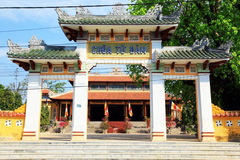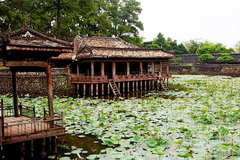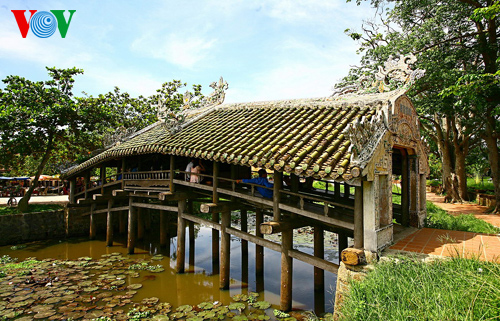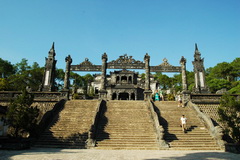



.jpg)

Tu Dam Pagoda was designed following the model of a Conference Pagoda (Chua Hoi). The old and new architectures blend together creating spacious and harmonious elements.Tu Dam Pagoda is one of the biggest and oldest pagodas in Hue. The pagoda was founded at the end of the 17th century (in about...

Le tombeau de Tu Duc est construit dans une vallée étroite appartenant au village de Duong Xuan Thuong (aujourd’hui, c’est le hameau de Thuong Ba, village de Thuy Xuan). Le tombeau est situé au milieu d’une immense forêt de pins, à 8 km du...

Thanh Toan old bridge built in 1776 for the connection between villages and a place to have some breeze during the summer day. The Bridge is one of the oldest bridge in Vietnam recognized by as country heritage in 1990

De tous les tombeaux impériaux qui jalonnent la rivière des Parfums, le mausolée de l’empereur Khai Dinh, l’avant-dernier souverain de la dynastie des Nguyên (1802-1945), est le plus étonnant, son architecture étant totalement différente...

The tomb of Gia Long is in fact a group of tombs including those of the Emperor's relatives. The whole compound is spread on a joint mountain with 42 small and big mounts, amongst which Dai Thien Tho is the biggest.To visit Gia Long's tomb, tourists can go by boat about 18km along...

The nine Dynastic Urns are the greatest bronze ones in Vietnam They were cast by Emperor Minh Mang in 1836 to symbolize the sovereignty of the dynasty.Each of them is named after the posthumous title of the emperors worshipped in the The Mieu Temple. For example, Cao Urn is named after Emperor...

Le temple de la Littérature est un temple confucéen du Viêt Nam, situé sur la rive gauche de la rivière des Parfums à un kilomètre de la pagode de la Dame céleste à l'ouest de la ville de Hué.Sous le règne des...

Elle sert d’entrée principale et de façade de la Cité Impériale. Construite en 1833 sous le règne de Minh Mang au moment du ré-aménagement de la Cité. La Porte du Midi constitue un ensemble d’architectures diversifié, elle...

La rivière des Parfums (Sông Hương) tire son nom des nombreuses herbes médicinales qui poussaient sur ses rives. Nombreux villages de sampans avec leurs petits autels et les offrandes sur le toit, à l’intention des génies de l’eau. La...

Dong Khanh's Tomb construction lasted through the lives of four Emperors Nguyen (1888-1923). That's why it bears the stamp of two architectural inclinations of two different historical periods. After being crowned, Dong Khanh had a temple built beside his father's tomb named Truy Tu...

Soyez le premier à connaître nos offres de voyage exclusives et les nouveaux circuits !.